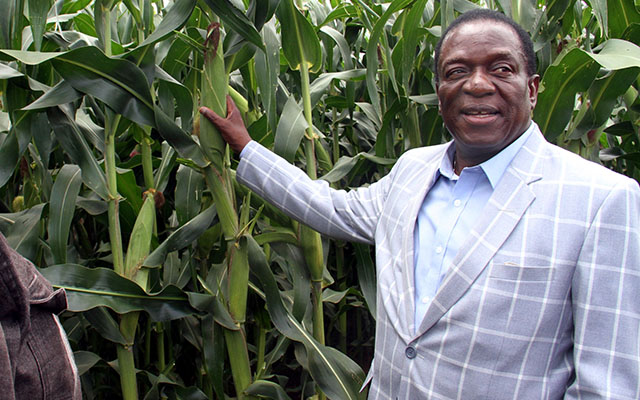Difficult times demand command management


VP Mnangagwa
Takunda Maodza Assistant News Editor
IT took President Mugabe’s remarks one day during a meeting with senior officials “tosvika riiniko tichitenga chigabe?” to jostle officials across State bureaucracy to think Command Agriculture. That was sometime around August 2016.
It was then that a team of technocrats across ministries and other Government institutions was put in place under the stewardship of Vice President Emmerson Mnangagwa to ensure Zimbabwe does not import maize ever again.
VP Mnangagwa was chosen to oversee Zimbabwe’s journey back to the bread basket status by virtue of him chairing the food and nutrition cluster in the economic blueprint — Zim-Asset.
Thus the idea of going Command Agriculture was born sometime in August last year. Once conceived, its implementation took the speed of a Russian Tu-160 bomber.
A technocrat in Command Agriculture remarked to this writer: “In my entire service as a civil servant, I do not remember any Government programme that has been implemented at such speed and collectiveness of purpose as Command Agriculture.”
It should not come as a surprise therefore that six months after the idea of going Command Agriculture was born, Government is having — for once in a very long time — a positive headache.
Come harvest time, the nation will battle to find enough storage space as the silos at the Grain Marketing Board (GMB) are not enough to contain proceeds from Command Agriculture.
The grain storage headache was admitted by none other than VP Mnangagwa at a church service in Kuwadzana, Harare, recently.
“The challenge that we are now facing is that of storing the maize,” he said.
VP Mnangagwa’s remarks reminded me of how as a young boy growing in Nyajena communal lands in Masvingo South, we always had a headache when after harvesting maize and leaving the harvest outside overnight to dry, rains would come from nowhere disturbing our sleep as it was required of us to wake up and carry the harvest to safety.
One of my brothers would always complain: “Ko iye muchembere unomborimireiko mabagwe akawandisa? Zvinotikuvadza musana nekusenga izvi.” (Why does our mother grow a lot of maize, since we end up having back problems, carrying it to safety?)
We would all then complain, but would not stop carrying our maize to safety, fully knowing at the back of our minds what the bumper harvest meant for the family. It was a positive headache.
Assessment made so far by the State points to a bumper harvest. There is no doubt about it, no matter how goaded the devil might be. It is a fact too that Command Agriculture is but the product of the land reform exercise embarked on by Government close to two decades ago.
It is a continuation of the agrarian reform whose implementation, like all revolutions, has to be vigorous. Don’t they say difficult times call for drastic measures? The mathematics of Command Agriculture is simple yet pregnant with yields. It goes — 400 000 hectares put under maize! Each farmer contracted under Command Agriculture mandated by the State after receiving inputs, to produce at least five tonnes per hectare.
Expected maize yield equals two millions tonnes of maize, an amount that far exceeds national consumption.
We consume roughly 1,8 million tonnes of maize annually. Even if we were to go by the figures given to Parliament by Agriculture, Mechanisation and Irrigation Development Minister Dr Joseph Made recently, the nation will still abundantly feed itself.
Dr Made indicated that as at February 9, 2017, a total of 153 000 hectares of maize had been planted under the Command Agriculture model even though over 190 000 hectares had already been prepared for maize production.
More hectarage could have been planted thereafter but let us deal with the figures given.
At a target of five tonnes per hectare and with 153 000 hectares planted, the output translates to 765 000 tonnes of maize from the Command Agriculture project.
But indications by VP Mnangagwa recently were that the majority of farmers under Command Agriculture have positively defied the five-tonne per hectare target. They are expecting between eight and 14 tonnes per hectare.
Let us be conservative and say they will produce eight tonnes per hectare. That would give us 1 224 000 tonnes just from farmers contracted under Command Agriculture. Assuming 200 000 hectares of maize were finally planted after the February 9 assessment, it translates to a million tonnes of maize at five tonnes per hectare. If the farmers produce eight tonnes per hectare, our harvest would total 1.6 million tonnes from Command Agriculture only. I know some are already questioning why I am being biased and assuming that farmers will produce only five tonnes and above.
Use any figures comrades, but it all points to full bellies. Besides, we also had the Presidential Input Support Scheme under which thousands of farmers benefited and would produce not only enough for their families but have excess to feed Zimbabwe.
In fact, Dr Made indicated in his submissions to Parliament that the total area of maize planted in the country including by farmers not under Command Agriculture was 1 243 624 hectares.
For the pessimistic, assume from the 1 243 624 hectares every farmer will produce two tonnes per hectare, the tonnage generated would be 2 487 248.
Be even more negative and say they will produce one and half tonnes per hectare and total yield will still be above our consumption requirements at 1 865 436 tonnes. During the 2015-16 cropping season, only 773 968 hectares were put under maize. Away from figures, what does a bumper harvest of the staple food mean for the nation even on the international arena? It means fulfilment of one of the most scared rights as enshrined in the Universal Declaration of Human Rights — the right to food.
Article 25 of the Universal Declaration of Human Rights states that “everyone has the right to a standard of living adequate for health and well-being of himself and of his family, including food.” The right to food is also enshrined in the 1966 International Covenant on Economic, Social and Cultural Rights.
Simply put, hunger is a violation of human rights. Article 25 of the Universal Declaration of Human Rights is also clear on what role Government must play in promoting and safeguarding citizens’ rights to food. The State’s role in ensuring people eat sufficiently is aptly captured by the Food and Agriculture Organisation legal officer Margret Vidar, who states that “the State’s obligation to fulfil the right to food comprises two elements – the obligation to facilitate and the obligation to provide.
“The obligation to facilitate means that it (State) should create and maintain an enabling environment within which people are able to meet their needs.”
It goes without saying therefore that Command Agriculture and even the Presidential Input Support Scheme are but attempts by Government at creating that enabling environment for its citizens to produce enough to feed themselves.
In fact, the enabling environment was created the moment the State embarked on the agrarian revolution, which also saw the implementation of the farm mechanisation programme, and plans to revive irrigation at national level.
So, are there any lessons so far drawn from the Command Agriculture project?
Considering the fact that the $500 million financial package that propelled the project to success was mobilised entirely from local firms, largely indigenous ones, Command Agriculture stands tall like the Burj Khalifa, pointing to the success of well-thought-out and crafted public-private partnerships (PPPs), for a nation like Zimbabwe, which has been under Western siege for nearly two decades.
The tendency was to seek assistance abroad. The political economy of foreign aid is as clear as the summer sun. It comes with stringent strings attached to levels of being commandeered to accepting dirty moral values like homosexual rights, before aid comes your way for he who pays the piper calls the tune.
Feedback: [email protected]










Comments